Lenovo Y460P, Y560P User Manual
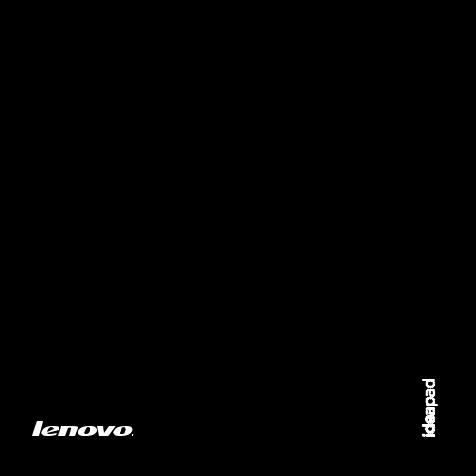
Lenovo
IdeaPad Y460p/Y560p
User Guide V1.0

Notes
•Before using this information and the product it supports, be sure to read Important safety information on page iii and Notices in Appendix E first.
•Some instructions in this guide may assume that you are using Windows® 7. If you are using other Windows operating system, some operations may be slightly different. If you are using other operating systems, some operations may not apply to you, but it won’t substantially affect your use of this computer.
•The features described in this guide are common to most models. Some features may not be available on your computer and/or your computer may include features that are not described in this user guide.
•The illustrations used in this manual are for Lenovo IdeaPad Y560p unless otherwise stated.
•The illustrations in this manual may differ from the actual product. Please refer to the actual product.
First Edition (September 2010)
© Copyright Lenovo 2010.
LENOVO products, data, computer software, and services have been developed exclusively at private expense and are sold to governmental entities as commercial items as defined by 48 C.F.R. 2.101 with limited and restricted rights to use, reproduction and disclosure. LIMITED AND RESTRICTED RIGHTS NOTICE: If products, data, computer software, or services are delivered pursuant a General Services Administration “GSA” contract, use, reproduction, or disclosure is subject to restrictions set forth in Contract No. GS-35F-05925.

Respective Users
Dear user,
Thank you for purchasing your new Lenovo notebook computer! Before using this product, make sure to read this user guide carefully.
We are pleased that you have chosen Lenovo for your mobile computing needs. To help you master the usage of your new computer quickly, we have prepared this user guide. In this manual you will find information on the system configuration, basic operating instructions, and important notices. We have done our best to avoid any errors in making sure that the information provided in this manual is accurate and reliable. However, due to the short length of the user guide it is impossible to cover all topics in great depth. For this reason, we apologize for any omissions you might find.
Lenovo is always trying to improve the performance and reliability of its products. For that reason, the hardware and software components shown within the user guide might not perfectly match those of your system.
However, any inconsistencies between what is described in the user guide and the operations of your computer should not substantially affect your use. Lenovo apologizes for any inconvenience that this issue might cause.
Thank you for your cooperation.

Explanation of hard disk capacity
Dear user,
While using your computer, you may find that the nominal hard disk capacity indicated is somewhat different from the disk capacity displayed by the operating system. For example, a nominal 40GB hard disk will appear as less than 40GB in the operating system. This discrepancy is not an error in hard disk installation nor any other problem, but a normal phenomenon of computers. This phenomenon is primarily due to the following reasons:
I.Different standards used by the manufacturer and operating system when calculating hard disk capacity
Hard disk manufacturers use a radix of 1000, i.e., 1G = 1,000MB, 1MB = 1,000KB, 1KB = 1,000 bytes. However, when identifying hard disk capacity, operating systems use a radix of 1024, i.e., 1GB = 1,024MB, 1MB = 1,024KB, 1KB = 1,024 bytes. The standard adopted by your computer is that of the hard disk manufacturers. Since the standards adopted by the hard disk manufacturer and operating system are different, the hard disk capacity displayed by the operating system will be different from the nominal hard disk capacity.
For example, if the hard disk is nominally X G, even when it is completely
empty, the capacity displayed by the operating system will be: X × 1000 × 1000 × 1000/ (1024 × 1024 × 1024) ≈ X × 0.931 G

In addition, if a portion of the hard disk space has been used for some specific purpose, then the capacity indicated by the operating system will be even less than X × 0.931 G.
II.A portion of the hard disk space is used for specific purposes
Lenovo computers may come with preinstalled OneKey Rescue System, so the hard disk has a special portion partitioned before delivery, which is used to store hard disk mirror and OneKey Rescue System program files. The size of the reserved space for this partition varies according to the model, operating system and software of the computer. For the sake of safety, this partition is not apparent, which is commonly referred to as a “hidden partition”.
In addition, after the hard disk is partitioned or formatted, the system will assign a certain amount of hard disk space for the system files.
For the above reasons, the available hard disk space indicated by the operating system is always less than the computer’s nominal hard disk capacity.


Contents |
|
Important safety information...... |
iii |
Important safety information.... |
iii |
Chapter 1. Getting to know your |
|
computer ....................................... |
1 |
Top view........................................ |
1 |
Left-side view ............................... |
4 |
Right-side view............................. |
5 |
Front view ..................................... |
7 |
Bottom view.................................. |
8 |
Chapter 2. Learning the basics.... |
11 |
First use........................................ |
11 |
Using AC adapter and battery.... |
14 |
Using the touchpad.................... |
17 |
Using the keyboard.................... |
20 |
Special keys and buttons........... |
23 |
System status indicators............ |
27 |
Securing your computer............ |
28 |
Connecting external devices..... |
30 |
Using Switchable Graphics |
|
(specific models only)................ |
33 |
Chapter 3. Using the Internet .... |
34 |
Wired connection ....................... |
34 |
Wireless connection ................... |
36 |
Chapter 4. OneKey Rescue |
|
System ......................................... |
38 |
OneKey Rescue System ............. |
38 |
Chapter 5. Troubleshooting ....... |
41 |
Frequently Asked Questions .... |
41 |
Troubleshooting ......................... |
44 |
Chapter 6. Upgrading and |
|
replacing devices ........................ |
53 |
Replacing the battery................. |
53 |
Replacing memory ..................... |
55 |
Replacing the hard disk drive.... |
59 |
Appendix A. Getting help |
|
and service .................................. |
64 |
Getting help on the Web ........... |
65 |
Calling the customer support |
|
center............................................ |
65 |
Getting help around the world... |
68 |
Lenovo warranty service |
|
telephone numbers..................... |
68 |
Appendix B. Use and care |
|
information .................................. |
69 |
Caring for your computer......... |
69 |
Accessibility and comfort.......... |
76 |
Maintenance................................ |
78 |
i

Contents |
|
Appendix C. Lenovo limited |
|
warranty ...................................... |
83 |
Warranty information ............... |
93 |
Appendix D. Customer replaceable |
|
units (CRUs)................................ |
97 |
Appendix E. Notices................... |
99 |
Notices......................................... |
99 |
ENERGY STAR model |
|
information ............................... |
102 |
Wireless related information.... |
104 |
TV tuner information |
|
(Y560p only).............................. |
108 |
Electronic emissions notices... |
111 |
WEEE and recycling |
|
statements ................................. |
118 |
Turkish statement of |
|
compliance................................ |
118 |
EU WEEE statements .............. |
119 |
Japan recycling statements..... |
120 |
Notice for users in the U.S.A.... |
122 |
Notice on deleting data |
|
from your hard disk ................ |
122 |
Appendix F. Features and |
|
Specifications........................... |
124 |
Trademarks............................... |
126 |
Index.......................................... |
127 |
ii

Important safety information
 Important safety information -----------------------------------------
Important safety information -----------------------------------------
This information can help you safely use your notebook personal computer. Follow and retain all information included with your computer. The information in this document does not alter the terms of your purchase agreement or the Lenovo Limited Warranty. For more information, see “Appendix C. Lenovo limited warranty” on page 83.
Read this first
Personal computers are electronic devices. Power cords, power adapters, and other features can create potential safety risks that can result in physical injury or property damage, especially if misused.
The safety risks are categorized as follows:
Danger:
Physical injury or even death may be caused.
Attention:
Property damage or even minor injury may be caused.
To protect yourself from hazards and create a safer computer work environment, follow the instructions hereafter.
iii

Important safety information
Unpack
Inspect the covers of the computer and the AC adapter, especially parts with the following labels attached for any crack or damage.
Danger:
•Hazardous voltage, current, and energy levels are present inside any component that has this label attached.
iv
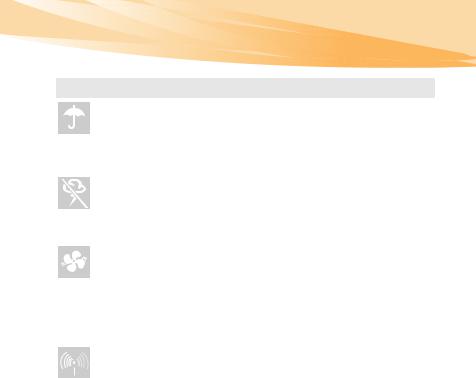
Important safety information
Working place
Do NOT use the computer in humid places such as a bathroom. Keep the computer and other parts away from liquids.
Danger:
• An electric shock may be caused by spilled liquid.
Do NOT use the computer during a lightning storm.
Attention:
•Lightning storm may damage the computer and result in an electric shock.
Keep a good ventilation of the computer and other parts.
Danger:
•Placing the working computer or other parts on a bed, sofa or other flexible surface may block the ventilation slots causing overheat of your computer or other parts to overheat or even catch a fire.
Turn off wireless devices where they may cause interference, such as in a hospital or at an airport.
v

Important safety information
On using
Use ONLY the power cord, power adapter and battery pack shipped with the computer and never use them with another product.
Be sure the power outlet is suitable for the plug and provides the correct voltage and current for the product you are installing.
Danger:
•An unsuitable power supply may damage your computer or cause an electric shock or fire.
Do NOT use a power outlet, power cord, power adapter or battery pack that appears to be damaged or corroded.
Do NOT share an electrical outlet with other home or commercial appliances that draw large amounts of electricity.
If power strips are used, the load should NOT exceed the power strip’s input rating. Unplug the power cord if there is a cracking, hissing, or a popping sound, or a strong odor comes from the computer.
Danger:
•Overloading the power supply may cause unstable voltages which might damage the computer, data, or attached devices, or even cause a fire.
vi

Important safety information
Do NOT wrap the power cord around the power adapter or other objects.
Do NOT squeeze or pinch the cord, or place heavy objects on it.
Attention:
•Stressing the cord may cause the cord to fray, crack or crimp which may present a safety hazard.
Avoid keeping your hands, your lap, or any other part of your body in contact with a hot section of the working computer for any extended length of time.
Attention:
•Extended contact with your body, even through clothing, could cause discomfort or even a skin burn.
Do NOT drop, bump, scratch, hit or place heavy objects on the liquid crystal display (LCD) of your computer.
Attention:
•Direct contact with liquid crystal material from a broken LCD is hazardous; if contact occurs, rinse with large amount of running water for more than 15 minutes.
vii

Important safety information
Service and upgrades
Do NOT attempt to service a product yourself unless instructed to do so by the customer support center or your documentation.
Attention:
•Do NOT take risks or attempt to diagnose the situation yourself. Contact the customer support center for further guidance. For a list of service and support phone numbers, go to http://consumersupport.lenovo.com.
Lenovo provides documentation with instructions when it is appropriate for customers to install options or replace units (CRUs). Closely follow all instructions when installing or replacing parts.
Disconnect the attached power cords, battery pack, and all the cables before you open the device covers, unless instructed otherwise in the installation and configuration procedures.
Keep the covers closed whenever the computer is plugged in.
viii
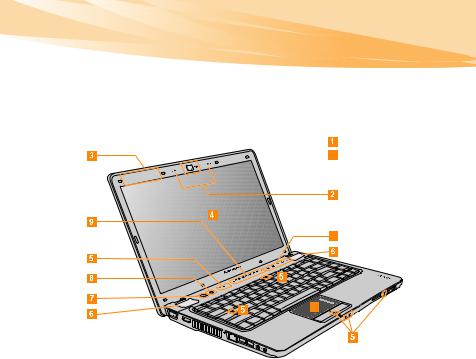
Chapter 1. Getting to know your computer
 Top view -------------------------------------------------------------------------------------------
Top view -------------------------------------------------------------------------------------------
IdeaPad Y460p
 3
3
10
Y460p
11
1
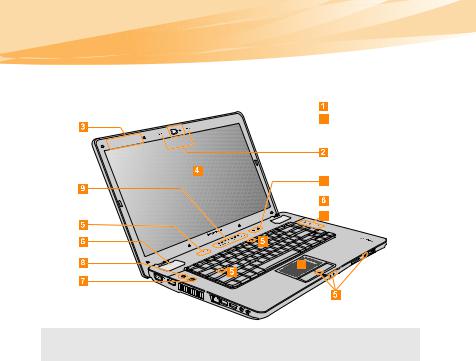
Chapter 1. Getting to know your computer
IdeaPad Y560p
|
p |
60 |
|
Y5 |
|
 3
3
10
 10
10
11
Note: The illustrations in this manual may differ from the actual product. Please refer to the actual product.
Attention:
•Do NOT open the display panel beyond 135 degree. When closing the display panel, be careful NOT to leave pens or any other objects in between the display panel and the keyboard. Otherwise, the display panel may be damaged.
2

Chapter 1. Getting to know your computer
Integrated |
Use the camera for video communication. |
camera |
|
Built-in microphone
Wireless module antennas
Computer display
The built-in microphone (with echo cancellation and noise reduction) can be used for video conferencing, voice narration, or simple audio recordings.
The built-in antennas ensure optimal reception of wireless communication radio.
The LCD display provides brilliant visual output.
System status For details, see “System status indicators” on page 27. indicators
Speakers
Power button
OneKey Rescue System button
The JBL certificated speakers provide rich and powerful sound.
Press this button to turn on the computer.
Press this button to open OneKey Rescue System (If OneKey Rescue System has been preinstalled) when the computer is powered off.
|
Note: For details, see “Chapter 4. OneKey Rescue System” on page 38. |
|
|
Lenovo SlideNav |
For details, see “Lenovo SlideNav bar” on page 25. |
|
bar |
|
|
Cap sensor |
For details, see “Cap Sensor buttons” on page 26. |
10 |
||
|
buttons |
|
|
Touchpad |
The touchpad functions as a conventional mouse. |
11 |
||
Note: For details, see “Using the touchpad” on page 17.
3

Chapter 1. Getting to know your computer
 Left-side view ------------------------------------------------------------------------------
Left-side view ------------------------------------------------------------------------------
|
|
|
|
|
|
|
|
|
|
|
|
|
|
|
|
|
|
|
|
|
|
|
|
|
|
|
|
|
|
|
|
|
|
|
|
|
|
|
|
|
|
|
|
|
|
|
|
|
1 |
|
2 |
|
3 |
|
4 |
|
|
5 |
|
|
6 |
|
7 |
|
|||||||
VGA port |
|
|
Connects to external display devices. |
|
|
|
|
|
|
|
|
|
|
||||||||||
HDMI port |
|
|
Connects to devices with HDMI input such as a TV or a |
||||||||||||||||||||
|
|
|
|
|
|
display. |
|
|
|
|
|
|
|
|
|
|
|
|
|
|
|||
Fan louvers |
|
|
Dissipate internal heat. |
|
|
|
|
|
|
|
|
|
|
|
|
|
|
||||||
Note: Make sure that none of the fan louvers are blocked or else overheating of the computer may occur.
RJ-45 port |
Connects to an Ethernet network. |
Note: For details, see “Wired connection” on page 34.
USB port |
Connects to USB devices. |
Note: For details, see “Connecting a universal serial bus (USB) device” on page 32.
Headphone jack Connects to an external headphone.
Attention:
•Listening to music at high volume over extended periods of time may damage your hearing.
Microphone jack Connects to an external microphone.
4
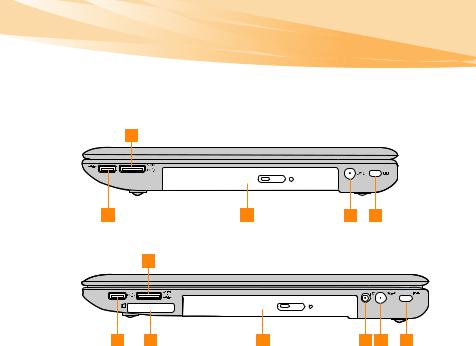
Chapter 1. Getting to know your computer
 Right-side view --------------------------------------------------------------------------
Right-side view --------------------------------------------------------------------------
IdeaPad Y460p
2
1 |
4 |
6 |
7 |
IdeaPad Y560p
2
1 |
3 |
4 |
5 |
6 |
7 |
5

Chapter 1. Getting to know your computer
USB port |
Connects to USB devices. |
Note: For details, see “Connecting a universal serial bus (USB) device” on page 32.
eSATA/USB |
Connects to eSATA or USB devices. |
combo port |
|
Note: For details, see “Connecting a universal serial bus (USB) device” on page 32.
ExpressCard Slot (Y560p)
Optical drive
Connects to ExpressCard devices that are compatible with the ExpressCard/34 interface.
Your computer comes with an optical drive, such as a CD/ DVD drive.
TV-in jack |
Use this jack to connect with TV signal cable through the |
(specific models |
provided TV adapter (Analog/digital input supported). |
only) (Y560p) |
|
AC power |
Connect the AC adapter here. |
adapter jack |
|
Note: For details, see “Using AC adapter and battery” on page 14.
Kensington slot Attach a security lock (not supplied) here.
Note: For details, see “Attaching a security lock (not supplied)” on page 28.
6
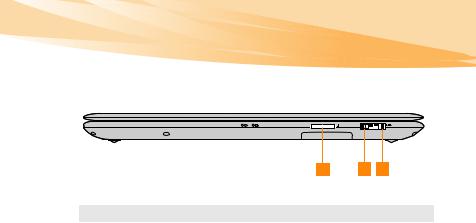
Chapter 1. Getting to know your computer
 Front view ---------------------------------------------------------------------------------------
Front view ---------------------------------------------------------------------------------------
1 |
2 |
3 |
Media card slot Insert media cards (not supplied) here.
Note: For details, see “Using media cards (not supplied)” on page 30.
GPU (graphics processing unit) switch (specific models only)
Integrated wireless device switch
After you toggle the GPU switch, the system will automatically choose and switch over to the integrated or dedicated GPU according to the current loading. (Note: For Y460p and Y560p, this switch is available only on models that support the switchable technology.)
Use this switch to turn on/off the wireless radio of all wireless devices on your computer.
7
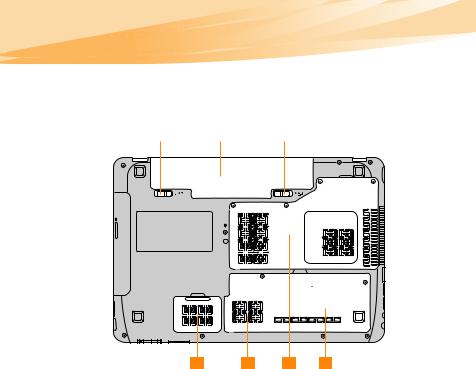
Chapter 1. Getting to know your computer
 Bottom view ----------------------------------------------------------------------------------
Bottom view ----------------------------------------------------------------------------------
IdeaPad Y460p
1 |
|
2 |
|
3 |
4 |
4 |
5 |
6 |
8
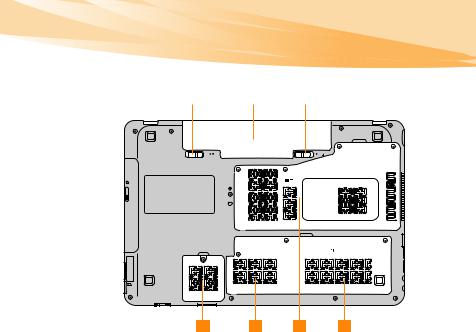
Chapter 1. Getting to know your computer
IdeaPad Y560p
1 |
|
2 |
|
3 |
4 |
4 |
5 |
6 |
9

Chapter 1. Getting to know your computer
Battery latchspring loaded
Battery pack
Battery latchmanual
Mini PCI ExpressCard slot compartment (specific models only)
The spring-loaded battery latch keeps the battery pack secured in place.
For details, see “Using AC adapter and battery” on page 14.
The manual battery latch is used to keep the battery pack secured in place.
Houses the computer’s TV card (Y560p only), wireless module or SSD card.
Central |
Houses the computer's CPU and memory. |
Processing Unit |
|
(CPU)/ Memory |
|
(RAM) |
|
compartment |
|
Hard disk drive |
Houses the computer's hard disk drive. |
(HDD) |
|
compartment |
|
Note: In the case of a non-WWAN configuration, customer upgrade is not supported. The icon in the bottom view is for reference only, and no practical function is available.
10

Chapter 2. Learning the basics
 First use -----------------------------------------------------------------------------------------------
First use -----------------------------------------------------------------------------------------------
Read the manuals
Read the supplied manuals before using your computer.
Connect to the power
The supplied battery pack is not fully charged at purchase.
To charge the battery and begin using your computer, insert the battery pack and connect the computer to an electrical outlet. The battery is automatically charged while the computer is running on AC power.
Install the battery pack
Refer to the supplied Setup Poster to install the battery pack.
Connect the computer to an electrical outlet
1 Connect the power cord to the AC adapter.
2Connect the AC adapter to the AC power adapter jack of the computer firmly.
3 Plug the power cord into an electrical outlet.
11

Chapter 2. Learning the basics
Turn on the computer
Press the power button to turn on the computer.
Configure the operating system
You may need to configure the operating system when it is first used. The configuration process may include the procedures below.
•Accepting the end user license agreement
•Configuring the Internet connection
•Registering the operating system
•Creating a user account
Putting your computer into sleep state or shutting it down
When you finish working with your computer, you can put it into sleep state or shut it down.
Putting your computer into sleep state
If you will be away from your computer for only a short time, put the computer into sleep state.
When the computer is in sleep state, you can quickly wake it to resume use, and bypass the startup process.
12

Chapter 2. Learning the basics
To put the computer into sleep state, do one of the following.
•Click  and select Sleep from the Start menu.
and select Sleep from the Start menu.
•Press Fn + F1.
Note: Wait until the power indicator light starts blinking (indicating that the computer is in sleep state) before you move your computer. Moving your computer while the hard disk is spinning can damage the hard disk, causing loss of data.
To wake the computer, do one of the following.
•Press the power button.
•Press any key on the keyboard.
•If you do not use the computer for a long time, the computer will switch from sleep to hibernation automatically. To wake it up, just press the power button.
Shutting down your computer
If you are not going to use your computer for a day or two, shut it down.
To shut down your computer, click  and select Shut Down from the Start menu.
and select Shut Down from the Start menu.
13

Chapter 2. Learning the basics
 Using AC adapter and battery -----------------------------------------------
Using AC adapter and battery -----------------------------------------------
Checking battery status
You can determine the percentage of battery power remaining by using Windows Power Options.
Note: As each computer user has different habits and needs, it is difficult to predict how long a battery charge will last. There are two main factors:
•The amount of energy stored in the battery when you commence work.
•The way you use your computer: for example, how often you access the hard disk drive and how bright you make the computer display.
Charging the battery
When you find that the battery power is low, you need to charge the battery or replace it with a fully charged one.
The battery is charged when the AC adapter is connected to the computer and the battery is installed.
Charging time will depend on the usage environment.
You need to charge the battery in any of the following situations:
•When you purchase a new battery.
•If the battery status indicator turns amber.
•If the battery has not been used for a long time.
14

Chapter 2. Learning the basics
Notes:
•You are advised to insert the battery pack when using your computer to prevent small particles from entering the inside of your computer.
•To increase the life of the battery pack, the computer does not start recharging the battery immediately after it drops from fully charged.
•Charge the battery at a temperature between 50 °F and 80 °F (10 °C-30 °C).
•Full charge or discharge is not required.
•To protect the computer system, we advise you not to insert or remove the battery when the computer is on.
Removing the battery pack
If you are not going to use the computer for an extended period of time, or if you need to send your computer to Lenovo for service, etc. remove the battery pack from the computer.
Before removing the battery pack, make sure the computer has been shut down.
15

Chapter 2. Learning the basics
Handling the battery
If the rechargeable battery pack is replaced with an incorrect type, there may be danger of an explosion. The battery pack contains a small amount of harmful substances. To avoid possible injury and detriment to the environment, pay attention to the following points.
Notes:
•Replace only with a battery of the type recommended by Lenovo.
•Keep the battery pack away from fire.
•Do not expose the battery pack to water or rain.
•Do not attempt to disassemble the battery pack.
•Do not short-circuit the battery pack.
•Keep the battery pack away from children.
•Do not put the battery pack in trash that is disposed of in landfills. When disposing of the battery, comply with local ordinances or regulations and your company’s safety standards.
16
